
Welcome to our blog post all about the temperature settings on your clothes dryer.
If you’ve ever stood in front of that big metal box, scratching your head and wondering which setting to choose, don’t worry – you’re not alone. The temperature you select can make a big difference in how effectively your clothes dry, and even how long they last.
In this post, we’re going to dive deep into the world of low, medium, and high temperatures. We’ll weigh the pros and cons of each option so that you can make an informed decision that keeps your clothes looking fresh without sacrificing drying efficiency.
So, whether you’re a laundry guru or just someone who wants their clothes to come out nice and dry, let’s explore the best temperature settings for your dryer.
Should dryer be low medium or high temp
Contents
- 1 Should dryer be low medium or high temp
- 2 Understanding the Different Types of Fabrics
- 3 The Benefits of Setting a Dryer to Low Temperature
- 4 The Benefits of Setting a Dryer to Medium Temperature
- 5 The Benefits of Setting a Dryer to High Temperature
- 6 Factors to Consider When Choosing a Temperature Setting
- 7 Tips for Minimizing Wrinkles in Clothes
- 8 How High Heat Can Impact Colors and Textures
- 9 Energy Efficiency and Sustainability Considerations
- 10 Conclusion
When it comes to drying clothes, finding the right temperature setting on your dryer is crucial for maintaining the quality of your garments. But should you go for low, medium, or high heat? In this article, we’ll explore the factors to consider when setting your dryer temperature and help you make an informed decision that will keep your clothes looking their best.
Fabric Type:
Different fabrics have different heat tolerance levels. Delicate materials like silk or wool require a low temperature setting to prevent damage and shrinkage. On the other hand, sturdier fabrics like cotton or denim can handle higher temperatures without harm.
Care Instructions:
Always check the care labels on your clothing items to determine the recommended drying temperature. These labels provide valuable information on how to best care for your clothes, including temperature guidelines. Following these instructions will help preserve the color, texture, and overall integrity of your garments.
Desired Outcome:
Consider what you want to achieve with your drying process. If you’re looking to minimize wrinkles, a higher temperature setting may be more effective at relaxing the fibers and reducing creasing. However, if preserving color and fabric softness is your priority, opt for a lower temperature setting.
Energy Efficiency:
Using lower temperature settings can save energy and reduce your carbon footprint. High heat can be more energy-intensive and lead to higher electricity bills. By choosing lower temperatures whenever possible, you contribute to a more sustainable lifestyle while still achieving effective drying results.
Specialized Settings:
Many dryers offer specialized settings for specific fabric types or garments. These settings are designed to optimize drying conditions for different materials, ensuring their longevity and quality. Take advantage of these options if your dryer has them, as they can provide tailored care for your clothes.
Understanding the Different Types of Fabrics
Drying your clothes after washing is a crucial step in laundry care. But did you know that setting the right temperature on your dryer can make a huge difference in preserving the quality of your fabrics? Let’s dive into the exciting world of fabric drying and discover the secrets to achieving perfect results every time.
Natural Fabrics: Cozy Comfort, Caring Dry
Natural fabrics like cotton and linen love to snuggle up with warmth, but too much heat can be a recipe for disaster. Set your dryer to low or medium heat for these fabrics to prevent shrinkage and keep them soft and cozy.
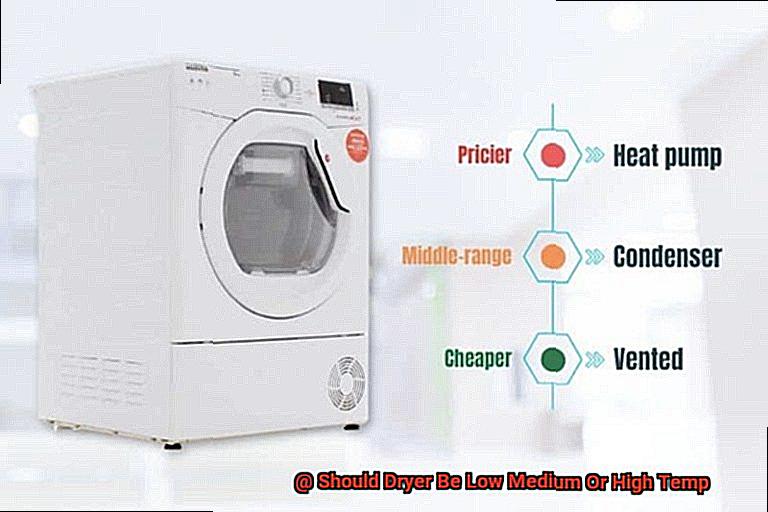
Synthetic Fabrics: Tough and Ready.
Synthetic fabrics like polyester and nylon are superheroes when it comes to drying. They can handle higher temperatures, so feel free to crank up the heat to medium or high. Just remember to check the care label for specific instructions.
Blended Fabrics: The Perfect Mix
Blended fabrics, such as soft poly-cotton or wool-acrylic blends, offer the best of both worlds. To keep these fabrics happy, choose a lower temperature setting to protect the delicate natural fibers from heat damage.
Delicate Fabrics: Handle with Care
Delicate fabrics like lace, chiffon, and silk need extra TLC when drying. Avoid high temperatures that can cause them to lose their shape or become damaged. Opt for a low temperature setting or try air-drying for that extra touch of gentleness.

Special Fabrics: Unique Needs
Some fabrics require special attention during drying. Waterproof or water-resistant fabrics, like raincoats or Gore-Tex jackets, should be dried on low heat to maintain their protective properties. Flame-resistant fabrics used in sleepwear should also be dried at low temperatures to preserve their safety features.
The Benefits of Setting a Dryer to Low Temperature
Doing laundry is a regular chore for most of us, and using a dryer is often a convenient way to speed up the drying process. However, did you know that setting your dryer to low temperature can bring numerous benefits? In this article, we will explore the advantages of using low heat settings, from preserving your clothes to saving energy and promoting sustainability.
Preserving Delicate Fabrics:
Delicate fabrics such as silk, lace, and cashmere require extra care to maintain their original shape and size. By setting your dryer to low temperature, you can prevent shrinkage and damage caused by high heat. This gentle approach ensures that your favorite delicate garments stay in pristine condition for longer.
Extending Clothing Lifespan:
We all have those go-to pieces in our wardrobe that we love to wear time and time again. Using high heat in the dryer can weaken the fibers of your clothes, leading to fraying, pilling, and overall deterioration. Choosing low temperature drying helps extend the lifespan of your garments, keeping them looking new and vibrant for years to come.
Preserving Colors:
Vibrant colors can fade quickly when exposed to high heat. By opting for low temperature drying, you can help preserve the original shades of your clothes. This is particularly important for colorful or patterned items that you want to keep looking fresh and vibrant.
Energy Efficiency:
Using high heat settings in your dryer consumes more energy, contributing to higher electricity bills and increased environmental impact. By setting your dryer to low temperature, you can save energy and reduce your carbon footprint. It’s a small change that can make a big difference.
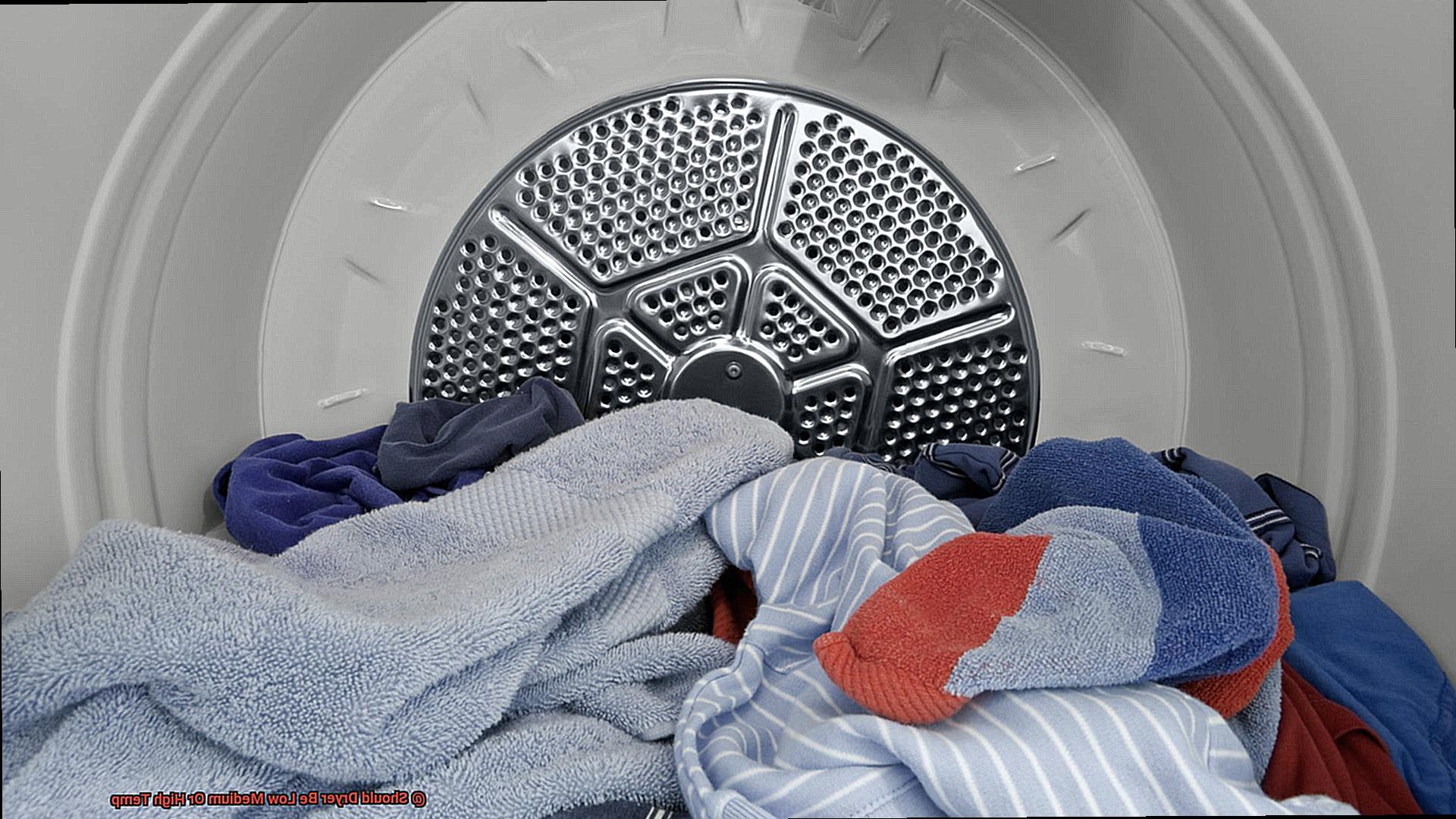
Reducing Wrinkles:
Nobody likes spending extra time ironing or steaming clothes that come out of the dryer excessively wrinkled. With low temperature drying, you can minimize wrinkling, saving you time and effort in your laundry routine.
Skin Sensitivity:
For individuals with sensitive skin or allergies, high heat can sometimes cause irritations or discomfort. By opting for low temperature drying, you can minimize the risk of adverse reactions and ensure that your clothes are safe to wear.
The Benefits of Setting a Dryer to Medium Temperature
When it comes to drying your clothes, finding the right temperature setting is crucial. While high heat may seem like the quickest way to get your clothes dry, it can actually do more harm than good. On the other hand, low heat may not effectively dry your clothes, leaving them damp and prone to odors. That’s why setting your dryer to medium temperature offers a sweet spot that balances efficiency and garment care. Let’s explore the benefits of this setting:
- Prevents shrinkage: One of the biggest advantages of using medium temperature is that it helps prevent shrinkage in your clothes. High temperatures can cause the fibers in fabrics to contract, leading to unwanted shrinkage, especially in delicate materials like wool or silk. By opting for medium temperature, you can ensure that your favorite sweater or silk blouse retains its original size and shape.
- Preserves color: Nobody wants their vibrant red shirt to turn into a dull pink after a few rounds in the dryer. High temperatures can cause dyes in fabrics to fade or bleed, especially with darker or brighter colors. By using medium temperature, you can preserve the color integrity of your clothes and keep them looking fresh and vibrant.
- Minimizes damage to clothing fibers: High temperatures can weaken the fabric and lead to fraying or pilling, especially with delicate or synthetic materials. On the other hand, low temperatures may not provide enough heat to effectively remove wrinkles or odors from clothes. Medium temperature strikes a perfect balance by efficiently drying your clothes without causing unnecessary wear and tear.
- Conserves energy and reduces costs: While high temperatures may dry clothes faster, they also consume more energy and result in higher electricity bills. By choosing medium temperature, you can still achieve efficient drying while being mindful of energy consumption and reducing your electricity costs.
Remember that not all fabrics require the same drying temperature. Natural materials like cotton or linen can tolerate higher temperatures without significant damage. However, for garments made of mixed fabrics or those with delicate embellishments or trims, it’s safer to opt for medium temperature to prevent any potential damage.
To make the most of this setting, be sure to follow other best practices like not overloading the dryer, removing clothes promptly once they are dry, and using fabric softeners or dryer sheets to reduce static and wrinkles.
The Benefits of Setting a Dryer to High Temperature
Setting your dryer to high temperature may be the solution you’ve been searching for. In this blog post, we’ll explore the advantages of using high heat in your dryer and how it can help you achieve faster drying times, sanitize your laundry, remove tough stains, and reduce wrinkles. Let’s dive in.
Faster Drying Times:
When you’re in a rush or have a busy schedule, waiting for your laundry to dry can be frustrating. Setting your dryer to high temperature accelerates the evaporation process, allowing your clothes to dry faster. This is particularly beneficial for heavy fabrics, thick towels, and bedding that tend to hold onto moisture.
Sanitization of Laundry:
Did you know that high temperature drying can help kill bacteria, viruses, and other microorganisms? This is especially important for items like undergarments, towels, and baby clothes that require thorough cleaning. By setting your dryer to high heat, you can ensure that your laundry is both dry and sanitized.
Stain Removal:
Stains can be a headache to deal with, but high temperature drying can make the task easier. The increased heat helps break down and loosen the bonds between stains and fabric fibers, making it easier for them to be removed during the washing process. Say goodbye to stubborn stains.
Wrinkle Reduction:
Ironing or steaming clothes after drying can be time-consuming. However, by setting your dryer to high temperature, you can reduce wrinkles in your clothing. The heat relaxes the fabric fibers, making them more pliable and less prone to creasing. Save time and effort with wrinkle-free clothes straight from the dryer.
Important Considerations:
- Not suitable for all fabrics: It’s crucial to check the care labels on your clothing and follow the manufacturer’s recommendations regarding drying temperatures. Some delicate fabrics can shrink or become damaged when exposed to high heat.
- Proper sorting and maintenance: To ensure optimal results, sort your laundry based on fabric type and weight. Additionally, regular maintenance of your dryer, such as cleaning the lint filter and ensuring proper ventilation, is essential when using high temperature settings.
Factors to Consider When Choosing a Temperature Setting
When it comes to doing laundry, choosing the right temperature setting for your dryer can make a big difference in the outcome of your clothes. Whether you’re trying to avoid shrinkage, preserve the quality of delicate fabrics, or simply achieve the desired level of dryness, there are several factors to consider. Let’s dive into the key factors that can help you make an informed decision:
- Fabric Type: Different fabrics have different heat tolerance levels, so it’s important to choose a temperature setting that aligns with the fabric you’re drying. Delicate fabrics like silk or lace require a low temperature setting to avoid damage or shrinkage. On the other hand, sturdier fabrics like denim or cotton can handle higher temperatures without any issues.
- Care Instructions: Always check the care instructions provided by the garment manufacturer. These instructions give specific guidelines on how to properly care for the fabric and often include recommendations for temperature settings in the dryer. Following these instructions will help ensure that your clothes retain their quality and last longer.
- Desired Level of Dryness: The temperature setting you choose can also impact the level of dryness you achieve with your clothes. Higher temperature settings tend to dry clothes faster, but they can also increase the risk of over-drying or damaging delicate fabrics. If you prefer your clothes to be slightly damp and finish drying naturally, a lower temperature setting would be more suitable. However, if you need your clothes to be completely dry and ready to wear immediately, a higher temperature setting may be necessary.
- Energy Efficiency: It’s important to consider energy efficiency when choosing a temperature setting for your dryer. Higher temperature settings require more energy to reach and maintain, resulting in higher electricity consumption. Opting for lower temperature settings can help reduce energy consumption and save money on utility bills in the long run.
- Environmental Impact: In addition to energy efficiency, the temperature setting you choose can have an environmental impact. Dryers that operate at higher temperatures release more heat into the surrounding environment, contributing to increased energy consumption and greenhouse gas emissions. By using lower temperature settings, you can reduce your carbon footprint and contribute to a more sustainable future.
- Personal Preference: Lastly, personal preference plays a role in choosing the temperature setting for your dryer. Some individuals prefer their clothes to be crisp and thoroughly dried, while others prefer a softer and less dry feel. Experimenting with different temperature settings can help you find the perfect balance that aligns with your personal preference.
By considering these factors when choosing a temperature setting for your dryer, you can ensure that your clothes are dried efficiently and safely, while also minimizing energy consumption and environmental impact.
Tips for Minimizing Wrinkles in Clothes
Are you tired of wrinkled clothes that make you look like a crumpled paper? Well, worry no more. I’m here to share some super cool tips on how to minimize wrinkles in your clothes.
Get ready to rock wrinkle-free outfits that will have you feeling confident and stylish all day long.
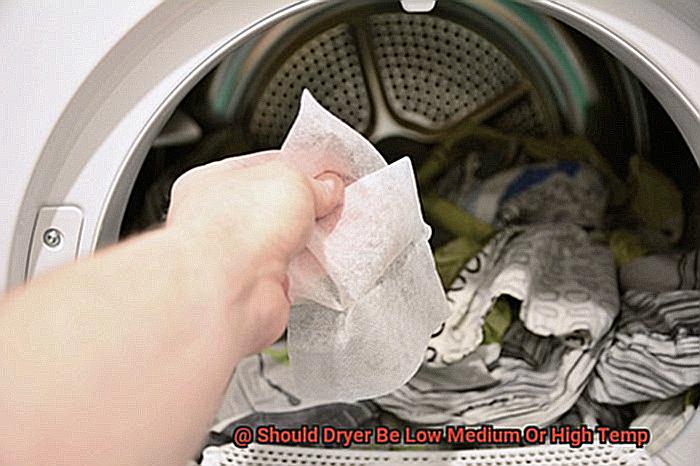
Tip 1: Shake It Out.
Before throwing your clothes into the dryer, give them a good shake. Just like when you shake a rug to get rid of dust, shaking your clothes helps loosen any wrinkles that may have formed during washing.
So, give those garments a shake and say goodbye to those pesky creases.
Tip 2: Choose the Right Dryer Settings
Did you know that the temperature setting on your dryer can make a big difference in preventing wrinkles? Use the low or medium heat setting instead of high heat because high heat can make your clothes shrink and fade.
By using lower temperatures, you’ll keep your clothes looking fresh and fabulous.
Tip 3: Time is of the Essence.
Don’t leave your clothes sitting in the dryer for too long after they’re dry. The longer they stay in that hot and cramped space, the more likely they are to get wrinkled.
So, as soon as your clothes are dry or slightly damp, take them out and hang them up or fold them neatly. Your clothes will thank you.
Tip 4: Get Soft and Smooth with Fabric Conditioners
You know those cool dryer sheets or fabric conditioners? They’re not just for making your clothes smell nice. They actually help reduce static and minimize wrinkles.
These magical products coat the fibers of your clothes, making them smoother and less likely to wrinkle. So, grab some fabric conditioner or dryer sheets to keep those wrinkles at bay.
Tip 5: Hang it Up or Lay it Flat
For delicate clothes like silk or linen, air-drying is the way to go. Lay them flat on a clean towel or hang them up to dry naturally. This will help preserve their shape and minimize wrinkling. So, say goodbye to the dryer for these special garments.
How High Heat Can Impact Colors and Textures
We all know the convenience of using a dryer to quickly dry our clothes. However, did you know that the heat in your dryer can have a significant impact on the colors and textures of your fabrics?
In this guide, we will explore the differences between high and low heat settings and how they can affect your clothing. So, grab your laundry basket and let’s dive in.
Color Fading:
One of the most noticeable effects of high heat is color fading. Fabrics exposed to excessive heat tend to lose their vibrancy over time. Delicate materials like silk, wool, or synthetic fibers are especially prone to color fading.
The dyes in these fabrics can break down and fade under high temperatures, resulting in a dull and washed-out appearance. To preserve the original color of your clothing, it is best to opt for a low or medium temperature setting on your dryer.
Texture Changes:
Heat can also impact fabric textures. Natural fibers like cotton or linen are particularly susceptible to shrinkage when exposed to high temperatures. These materials tend to contract, causing garments to decrease in size. You certainly don’t want your favorite pair of jeans to become too small.
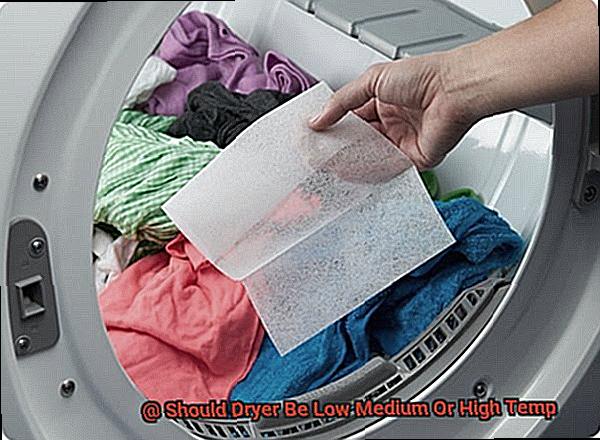
Additionally, high heat can make fabrics feel rougher and less soft. The excessive drying process can strip away natural oils and moisture from the fibers, leaving them stiff and uncomfortable against the skin.
Delicate Fabrics:
Certain delicate fabrics should never be subjected to high heat in a dryer. Lace, embroidery, or sequined clothing require extra care. The extreme heat can cause these decorative elements to melt or become damaged beyond repair.
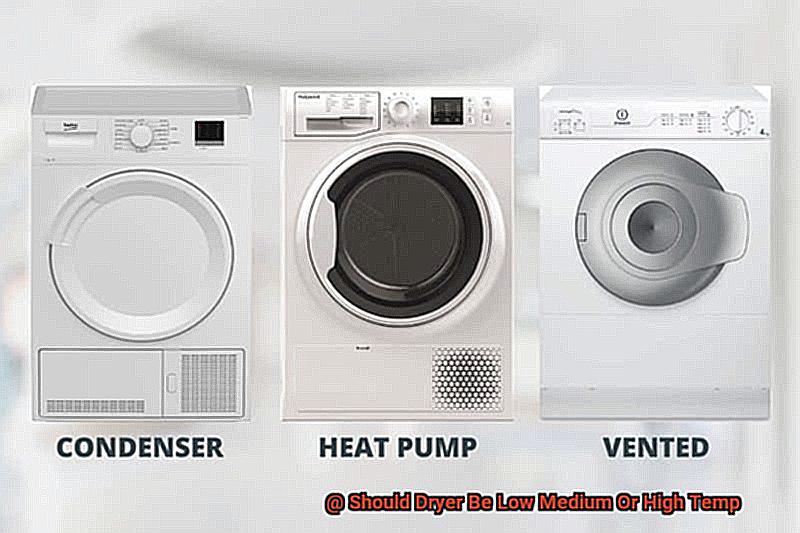
Always follow the care instructions on the garment’s label or err on the side of caution by using lower heat settings for delicate items.
Comparing High and Low Heat Settings:
Effect on Colors:
- High heat: Color fading, dull and washed-out appearance.
- Low heat: Preserves original color, vibrant and fresh appearance.
Effect on Textures:
- High heat: Shrinkage, rougher and less soft fabric.
- Low heat: Maintains size, retains softness and comfort.
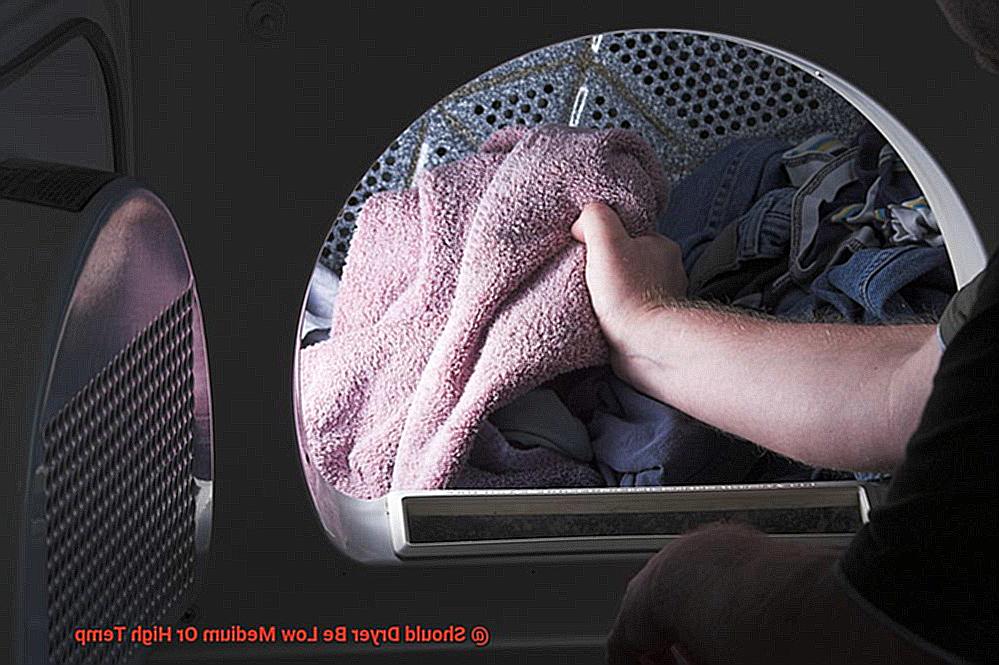
Effect on Delicate Fabrics:
- High heat: Can cause melting or damage to lace, embroidery, or sequins.
- Low heat: Preserves delicate elements, avoids irreversible damage.
Energy Efficiency and Sustainability Considerations
In today’s world, energy efficiency and sustainability are becoming increasingly important considerations for households. Dryers, being one of the most energy-intensive appliances, play a significant role in our energy consumption.
Here, we will explore how temperature settings, fabric type, and advanced features can contribute to energy efficiency and sustainability when using a dryer.
Temperature Settings:
- Low temperature settings: Opting for low temperature settings can significantly reduce energy consumption. While it may take longer to dry clothes, you can compensate by using shorter drying cycles or selecting a high spin speed on your washing machine to remove excess moisture before transferring clothes to the dryer.
- Medium temperature settings: These provide faster drying compared to low settings while still consuming less energy than high settings. They strike a balance between energy efficiency and drying time.
- High temperature settings: Reserved for bulky items or heavily soiled clothes, high temperatures require more energy and can potentially damage delicate fabrics or cause shrinkage. Use this setting sparingly.
Fabric Type:
Consider the fabric type when selecting the temperature setting:
- Delicate fabrics (e.g., silk or wool): Use lower temperature settings to prevent damage.
- Sturdy fabrics (e.g., cotton or denim): Higher temperatures can be used without risking damage.
Advanced Features:
Investing in a dryer with advanced features can further enhance energy efficiency and sustainability:
- Moisture sensors: These sensors detect when clothes are dry and automatically shut off the dryer, preventing over-drying and unnecessary energy consumption.
- Automatic shut-off: This feature helps conserve energy by turning off the dryer when the desired dryness level is reached.
Additional Tips:
- Clean the lint filter before each cycle: A clogged lint filter restricts airflow, forcing the dryer to work harder and consume more energy.
- Regular maintenance: Keep the dryer’s vent clean and free from obstructions to improve airflow efficiency.
Conclusion
In conclusion, when it comes to choosing the temperature setting for your dryer, it is important to consider the type of fabric you are drying.
Delicate fabrics such as silk or lace should be dried on low heat to prevent damage and shrinkage. Medium heat can be used for most everyday clothing items, ensuring they dry efficiently without causing excessive wear and tear.
On the other hand, high heat should only be reserved for heavy fabrics like towels or denim that require extra drying power. By selecting the appropriate temperature setting, you can extend the lifespan of your clothes and keep them looking their best.
Remember, a gentle touch goes a long way in preserving the quality and longevity of your garments.


